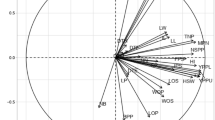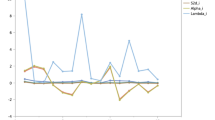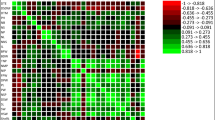Abstract
The present study was undertaken to delineate genotype–environment interactions and stability status of 16 genotypes of ashwagandha (Withania somnifera (L.) Dunal) in context to the 12 characters, namely plant height, number of primary branches, number of secondary branches, days to flowering, days to maturity, number of berries, number of seeds/berry, root length, root diameter, root branches, dry root yield and total alkaloid content (%). Experiment was carried out in a randomized complete block design with three replications over three different locations (S. K. Nagar, Jagudan and Bhiloda) in north Gujarat for three years (2016–17, 2017–18 and 2018–19). Pooled analysis of variance revealed that the mean squares due to genotypes and genotype × environment interaction along with linear and nonlinear components were highly significant (P<0.01) for most of the traits under study. Stability parameters for component traits through Eberhart and Russell model showed that genotypes that can be used directly in breeding programme are SKA-4 for early flowering, SKA-21 for early maturity and SKA-1, SKA-4, SKA-6 and SKA-17 for shorter plant height. Further, SKA-21 could be used for improving number of primary branches per plant, SKA-11 and SKA-17 for number of secondary branches per plant, SKA-19 for number of berries per plant, SKA-6, SKA-21, SKA-27 and AWS-1 for root branches and SKA-17 for root length as these genotypes were found to be most stable across the environments for mentioned traits. The result revealed that some reliable predictions about genotype × environment interaction and its unpredictable components were involved significantly in determining the stability of genotypes. Hence, the present investigation can be exploited for the identification of more productive genotypes in specific environments, leading to significant increase in root productivity of ashwagandha.
















Similar content being viewed by others
References
Anonymous 2007 Standardisation of single drugs of unani medicine, part III, 1st edition, pp. 9e14. Central Council for Research in Unani Medicine, New Delhi.
Anonymous 2016 Export analysis and trends of Withania roots. Accessed 30 December 2016 Available at https://www.zauba.com/exportanalysis-withaniaþroots-report.html.
Bradshaw A. D. 1965 Evolutionary significance of plasticity in plants. Adv. Genet. 13, 115–155.
Ceccarelli S. 1989 Wide adaptation, How wide? Euphytica 40, 197–205.
de Oliveira T. R. A., de Carvalho H. W. L., Nascimento M., Costa E. F. N., Junior A. T. A., de Gravina G. A. et al. 2018 The Eberhart and Russel’s Bayesian method used as an instrument to select maize hybrids. Euphytica 214, 64.
Eberhart S. A. and Russell W. A. 1966 Stability parameters for comparing varieties. Crop Sci. 6, 36–40.
Goksoy A. T., Sincik M., Erdogmus M., Ergin M., Aytac S., Gumuscu G. et al. 2019 The parametric and non-parametric stability analyses for interpreting genotype by environment interaction of some soybean genotypes. Turk. J. Field Crops 24, 28–38.
Mir B. A., Khazir J., Mir N. A., Hasan T. and Koul S. 2012 Botanical, chemical and pharmacological review of Withania somnifera (Indian ginseng): an ayurvedic medicinal plant. Indian J. Drugs Dis. 6, 2278–2958.
Mishra S. N. 1998 Quick methods of estimation of total alkaloid, pp. 27–30. All India Co-ordinated Research Project on Medicinal and Aromatic plants, presentation of trial data at C.C.S. Haryana Agricultural University, Hissar.
Nirmal Raj R., Renuka Devi C. P. and Gokulakrishnan J. 2019 G × E interaction and stability analysis of maize hybrids using Eberhart and Russell model. Int. J. Agric. Environ. Biotechnol. 12, 1–6.
Pour-Aboughadareh A., Yousefian M., Moradkhani H., Poczai P. and Siddique K. H. M. 2019 STABILITYSOFT: A online program to calculate parametric and non-parametric stability statistics for crop traits. Appl. Plant Sci. 7, e 01211.
Rocha M. M., Freire Filho F. R., Ribeiro V. Q., Carvalho H. W. L., Belarmino Filho J., Raposo J. A. A. et al. 2007 Yield adaptability and stability of semi-erect cowpea genotypes in the Brazil Northeast Region. Pesqui. Agropecu. Bras. 42, 1283–1289.
Sangwan O., Avtar R. and Amit S. 2013 Stability analysis in some ashwagandha [Withania somnifera (L.) Dunal] genotypes. Indian J. Plant Sci. 2, 66–71.
Scott G. E. 1967 Selecting for stability of yield in maize. American Breeding Association Report. In Heterosis, 4, 296–301. Iowa State College Press. Amer.
Sharma A., Vats S. K. and Pati P. K. 2014 Post-inflectional dynamics of leaf spot disease in Withania somnifera. Ann. Appl. Biol. 165, 429–440.
Sharma R. 2013 Agro-techniques of medicinal plants. 1st edition, pp. 31–33. Daya Publishing House, New Delhi.
Singh B., Saxena A. K., Chandan B. K., Gupta D. K., Bhutani K. K. and Anand K. K. 2001 Adaptogenic activity of a novel, withanolide-free aqueous fraction from the root of Withania somnifera. Phytother. Res. 15, 311e8.
Singh G., Sharma P. K., Dudhe R. and Singh S. 2010 Biological activities of Withania somnifera. Ann. Biol. Res. 1, 56–63.
Singh S. and Kumar S. 1998 Withania somnifera. The Indian Ginseng Ashwagandha. Central Institute of Medicinal and Aromatic Plants, Lucknow, India.
Tripathi A. K., Shukla Y. N. and Kumar S. 1996 Ashwagandha (Withania somnifera): a status report. J. Med. Aromatic Plant Sci. 18, 46e52.
Acknowledgements
The authors thank the Research Scientist, Seed spices research centre Jagudan, Dean Agriculture, Director of Research and Vice-Chancellor of S. D. Agricultural University, S. K. Nagar, Gujarat, India for allowing us to use the necessary facilities and infrastructure to carry out the present research work.
Author information
Authors and Affiliations
Corresponding author
Additional information
Corresponding editor: Manoj Prasad
Rights and permissions
About this article
Cite this article
KUMAR, M., PATEL, M., CHAUHAN, R. et al. Elucidation of genotype–environment interactions and genetic stability parameters for yield, quality and agromorphological traits in ashwagandha (Withania somnifera (L.) Dunal). J Genet 99, 59 (2020). https://doi.org/10.1007/s12041-020-01207-9
Received:
Revised:
Accepted:
Published:
DOI: https://doi.org/10.1007/s12041-020-01207-9




